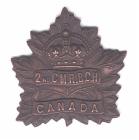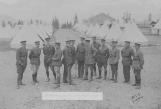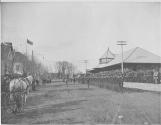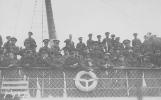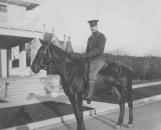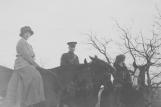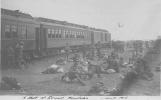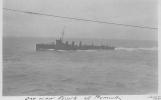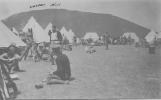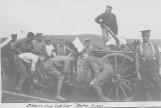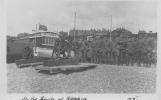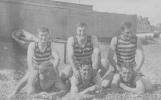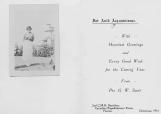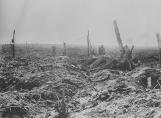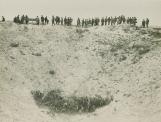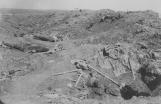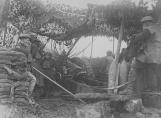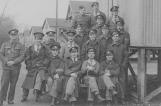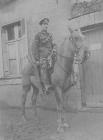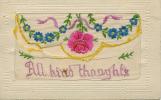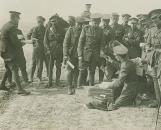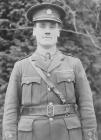

Okanagan Military Museum
Kelowna, British Columbia
1
02) The Great War 1914 -1918- Declaration
- Lt. Col. Bott's offer
- Mobilization of the 2nd CMRs
- Aid to Civil power
- Onto England
- Fighting as Infantry
- Lt. Col. "Whizzbang" Johnston
- Vimy Ridge
- Battle Honours
3
News that Great Britain had declared war on Germany and entered the European conflict early in August 1914 electrified the British Empire. In Canada, where much of the English speaking population had been born in Britain, the call to arms produced a flood of young men anxious "To Serve King and Country."It is difficult today to understand their eagerness to get into the fray. We have the benefit of hindsight. The conflicts of the late 19th Century had been brief, colonial affairs and relatively bloodless. There was great pride in the British Empire and Canada's place within it. Men were eager to take part in the great adventure before it was over. Everyone, including the military authorities, were completely unprepared for the carnage that was to be unleashed in the form of death by attrition in the muddy trenches of France and Flanders.
5
Responding to the call the Commanding Officer (CO) of the 30th BCH, Lt. Col. J.C.L. Bott pressed officials in Ottawa for orders to send the regiment overseas immediately. The early weeks of the war, however, demonstrated clearly that Infantry in trenches, and not Cavalry, would be the main tactical weapon in the age of heavy artillery and machine guns. Bott's request was refused and the regiment did not form a part of the first Canadian Division sent overseas, although a draft of men under Lt. Bell left the unit for Valcartier, Quebec, to join as independant soldiers.Throughout the fall of 1914 the 30th BCH remained in the Okanagan, and the men became increasingly impatient. Some indeed transferred to mobilized Infantry units in the hope of seeing action sooner. The remainder concentrated at Camp Vernon where they trained hard, but waited.
7
On Nov. 5, 1914 Britain declared war on Turkey, arousing hopes that there might be a need for Cavalry in the Middle East. Shortly thereafter, military officials in Ottawa authorized the formation of the 2nd Regiment, Canadian Mounted Rifles, with Lt. Col. Bott as CO. It was one of four Cavalry units raised for the Second Division. The new regiment became popularily known as the 2nd CMRs and Okanagan men flocked to it.The 2nd CMRs were an amalgamation of the volunteers from the 30th BCH and the Victoria Independant Squadron of Horse (VIS), another Militia unit formed shortly before the war on southern Vancouver Island.
17
The Okanagan unit contributed officers and men for Headquarters (HQ) and two full strength squadrons while the VIS contributed the third squadron for a total of 544 all ranks. The 30th BCH continued to exist as a Militia unit throughout the war. It provided reinforcement drafts for the Canadian Expeditionary Force (CEF) and guarded the German, Eastern European "Illegal Aliens" and Prisoners of War (POWs) interned in a camp established in the Vernon area late in 1914.19
The 2nd CMRs remained in tents in Victoria throughout the winter of 1914/15. They traded in the colourful uniforms of the 30th BCH for the khaki tunics, breeches and putties. However, they continued to be organized and to train as cavalry.Early in May 1915 the monotony of training was broken when a German submarine torpedoed and sank the British liner SS Lusitania off the Irish coast. There was great loss of civilian life, including one James Dunsmuir of the Vancouver Island mining dynasty, who had resigned his commission in the 2nd CMRs to enlist in a British regiment. The sinking infuriated the people of Victoria such that some of them vandalized premises belonging to or patronized by, those of German descent. Mounted patrols from the 2nd CMRs soon restored order and calm in the city.
31
Finally in June 1915 the regiment left Victoria by boat to catch a train to Montreal, then a ship to England. They were sent to a large camp near Shorncliffe called Ceasar's Camp, where they trained until September 1915 when they were ordered to the front in Flanders. Training in England was ambiguous as if to underline the uncertainty surrounding the role that the regiment would play. Still considered a cavalry unit horses and saddles were issued to it, although both never seemed to be available at the same time.When the 2nd CMRs were committed to battle, it was as infantry. In December 1915 after some months on the Western Front, the regiment was formally reorganized as an infantry unit with four companies instead of three squadrons. The men marked the occassion by burying their spurs in a field near the Front.
51
The regiment was engaged continuously in the major battles of the Western Front until the Armistice November 11, 1918, principally with the 8th Brigade within the 3rd Division of the Canadian Corps.During the last two years of the war, the regiment was under the command of Lt. Col. G.C. "Whizzbang" Johnston of Vernon. A "Whizzbang" was a type of German low-trajectory shell that made a whizz in flight and a bang on impact. Its bark was worse than its bite. He received the nickname from the weapon. His edited diary entitled "The 2nd Canadian Mounted Rifles (BC Horse) in France and Flanders" was published in 1932. It provides a graphic account of the many engagements in which the regiment took part, along with lists of casualties.
62
Aside from his literary talents, he demonstrated ingenuity by improving the performance of the Lee-Enfield rifle as a grenade thrower. The German rifle grenade consistently out distanced the allied rifle grenades giving them an advantage in close combat. Johnston decided to shorten the barrel of the issued Lee-Enfield .303 rifle as he thought it was too long for grenade launching properly. Cutting it down to 11 inches doubled the range of the rifle grenade.This discovery impressed Lt. General Sir Julian Byng, the Canadian Corps Commander who was busy planning the attack on Vimy Ridge, that soon every rifle grenade section had shortened their barrels.
Under Johnston's command and after two months of intense preparations, the 2nd CMRs took three lines of trenches and secured the centre of the Corp's objective in only 30 minutes on the morning of April 9, 1917. The ground taken by the regiment is just south of the location of the Vimy Memorial that stands upon the Ridge today.
67
The battle honours won by the regiment in the First World War were emblazoned on the Rgimental Colours and included: Mount Sorrel, Fler-Coucelette, Arras 1917-1918, Hill 70, Passchendeale, Scarpe 1918, Cana du Nord, Somme 1916, Ancre Heights, Vimy 1917, Ypres 1917, Amiens, Cambrai 1918, Pursuit to Mons, and France and Flanders 1915-1918. The price in blood for these honours was high.As casualties mounted, reinforcements from other parts of Western Canada and Ontario filled the gaps left by the dead and wounded. Still, the major element in the unit was British Columbian. More than 4,500 men served in the 2nd CMRs during the Great War. Of those, 732 were killed and 2,276 were wounded. Seven became Prisoners of War. This makes a total causalty rate of 67%.
Two members won the Victoria Cross, the highest decoration for Bravery in the British Empire. Major G. R. Pearkes won one while serving with the 5th CMRs in Passchendeale and Capt. J. "Jock" MacGregor won his at Nueville-Remy in 1918. In all, the men of the 2nd CMRs received 278 decorations by war's end. Following Armistice, the regiment returned to England and in March 1919 arrived in Victoria where they received a deservedly triumphant welcome home.



